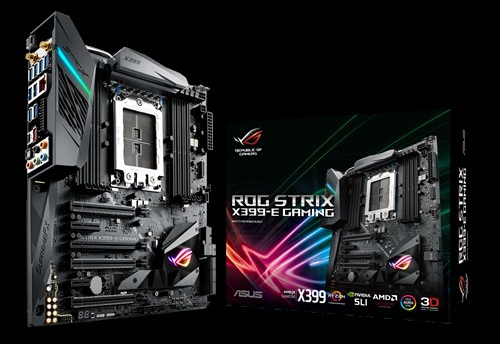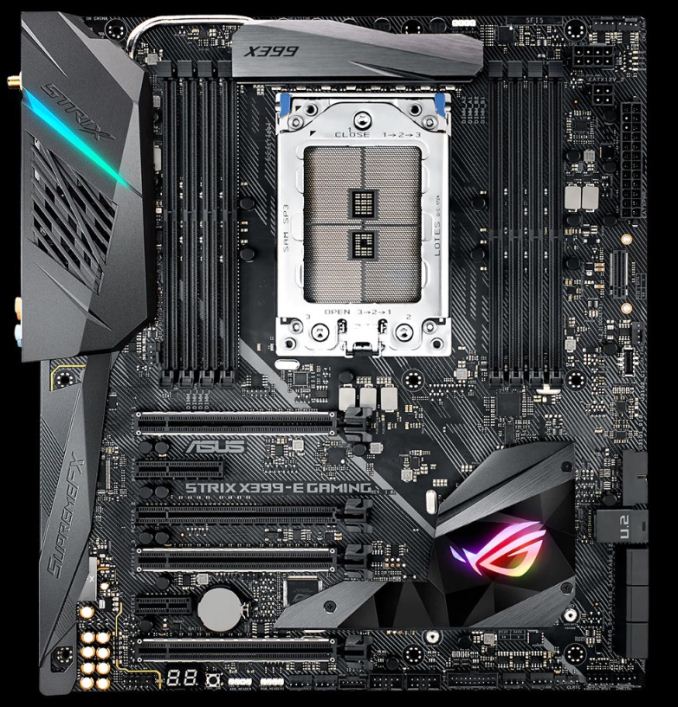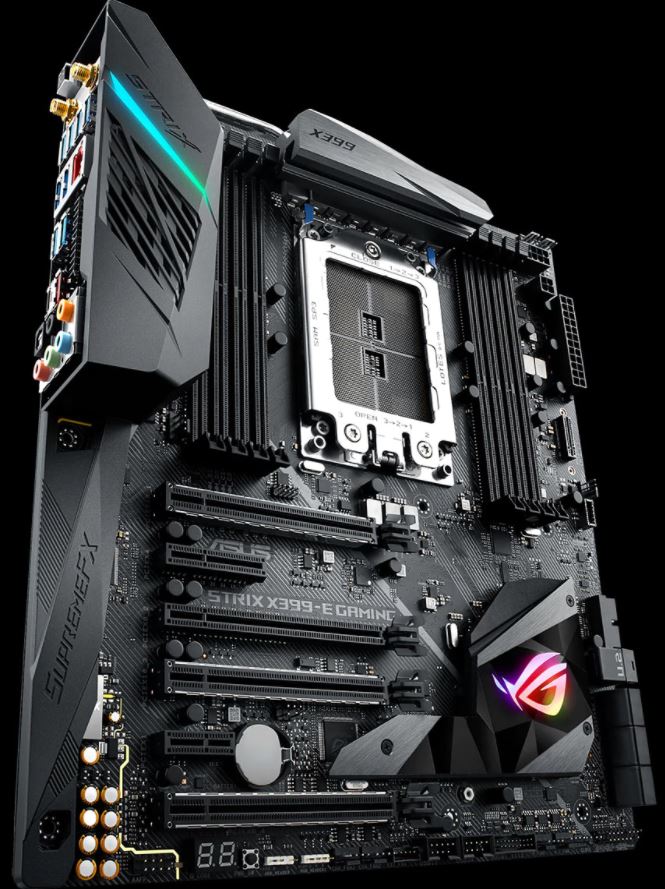An AMD Threadripper X399 Motherboard Overview: A Quick Look at Seven Products
by Ian Cutress & Joe Shields on September 15, 2017 9:00 AM ESTASUS ROG Strix X399-E Gaming
With the advent of eSports and the ability to stream and even broadcast your own gaming sessions, PC gaming has gained a significant amount of momentum the past few years. So much so, many (if not all) of the motherboard partners have latched on to the nomenclature and started entire lines for 'gaming' motherboards. ASUS is no different with gaming based motherboards, out for generations now under the ROG name, and continues to do so on the X399 Threadripper platform in the ROG Strix X399-E Gaming. Strix as a brand has migrated from a 'zero-noise' implementation to the more budget oriented gaming products from ASUS.
The ROG Strix falls between the Zenith Extreme and the Prime with a mix of features. For example, the Strix includes WiFi and Bluetooth connectivity, like the flagship Zenith Extreme, or that the Prime and Strix each have a single Intel I211-AT Gigabit LAN while the Zenith has three network ports including a 10 GbE. The Strix X399-E Gaming has eight DRAM slots, supports multiple GPUs (SLI and Crossfire), uses the latest audio codec (Supreme FX S1220A for the Strix), a capable VRM, multiple storage options, and RGB lighting among other features.
Looking over the board in detail, we'll start at the top. First, the VRM configuration is an eight-phase design. It is cooled by dual heat sinks running along the top of the socket with the second sitting between the memory slots and rear I/O. Extra cooling on the VRMs is provided by an included 40mm fan sitting under the I/O shroud (similar to the Zenith). Both EPS connectors, an 8-pin and 4-pin, as well as the 24-pin ATX connector, are in the top right-hand corner of the board. Below that is the second M.2 slot. An M.2 drive in this slot, like in the Prime, sticks out from the board instead of laying flat. ASUS does include an M.2 bracket for the slot to assist with supporting the standing device.
Continuing to move down the motherboard, below the vertical M.2 slot is the USB3.1 (10 Gbps) header fed from the chipset. For cases that have front panel USB 3.1 ports, this is typically the header used for that connectivity. Below that is the single U.2 port and six SATA ports.
The chipset heatsink on the ROG Strix houses RGB LEDs that can be adjusted with the AURA Sync software. The only other LEDs on the board are located on the I/O cover. The chipset heatsink extends on the bottom between the last two full-length PCIe slots and covers the first M.2 slot providing additional cooling for those devices.
The Strix offers four full-length PCIe slots, three use a reinforcing guard and is where users will slot their graphics cards for optimal performance. The PCIe arrangement allows for up to a triple slot video card between slot 1 and slot 3, and a dual slot card will fit between between slot 3 and slot 4. Slot breakdowns are x16 for single, x16/x16 for dual GPUs, and x16/x16/x8 when using three GPUs. Additionally there is one PCIe x1 slot, a PCIe x4 slot, and full-length PCIe slot (x4). These slots distinguish themselves by not having the reinforcement.
Across the bottom of the board are more onboard headers. These include external addressable RGB LED headers, fan headers, and USB3.0 headers. It also has a debug display as well as a small power button for testing outside of the case. On the left side of the board is where the audio parts are housed. Mostly concealed under the shroud is an EMI protected ALC1220A codec using upgraded filter caps, and PCB separation of the audio components from the rest of the board.
The rear I/O panel is fairly busy with a BIOS reset button, wireless connectivity, eight USB 3.0 ports, and the Gigabit Ethernet port taking up most of the real estate. USB 3.1 Type-A and Type-C ports from the ASMedia controller are also present, with the audio jacks, including SPDIF output, rounding out the rear panel.
| ASUS ROG Strix X399-E Gaming | |
| Warranty Period | 3 Years |
| Product Page | Link |
| Price | N/A |
| Size | ATX |
| CPU Interface | TR4 |
| Chipset | AMD X399 |
| Memory Slots (DDR4) | Eight DDR4 Supporting 128GB Quad Channel Up to 4133 MHz (OC) |
| Network Connectivity | 1 x Intel I211-AT GbE |
| Wireless Network | Wi-Fi 802.11 a/b/g/n/ac |
| Onboard Audio | SupremeFX S1220A |
| PCIe Slots for Graphics (from CPU) | 4 x PCIe 3.0 x16 Supports SLI/CF |
| PCIe Slots for Other (from Chipset) | 1 x PCIe 2.0 x4 (max) 1 x PCIe 2.0 x1 |
| Onboard SATA | 6x Supporting RAID 0/1/10 |
| Onboard SATA Express | None |
| Onboard M.2 | 2 x PCIe 3.0 x4 - PCIe or SATA |
| Onboard U.2 | 1 x PCIe 3.0 x4 |
| USB 3.1 | 1 x Header 1 x Rear Panel Type-A 1 x Rear Panel Type-C |
| USB 3.0 | 8 x Rear-Panel 2 x Header |
| USB 2.0 | 2 x Header |
| Power Connectors | 1 x 24-pin EATX 1 x 8-pin ATX 12V 1 x 4-pin ATX 12V |
| Fan Headers | 1 x M.2 1 x CPU 1 x CPU OPT 3 x Chassis 1 x AIO_PUMP 1 X w_PUMP+ 1 x 5-pin EXT_FAN |
| IO Panel | 1 x Intel NIC 1 x USB 3.1 Type-A 1 x USB 3.1 Type-C 8 x USB 3.0 1 x Optical S/PDIF out 5 x Audio jacks 1 x USB BIOS Flashback Button 1 x 2x2 Wi-Fi 802.11 a/b/g/n/ac |
ASUS mentioned pricing for the Strix X399-E Gaming to be at a more affordable price than their flaghsip ROG Zenith Extreme. It is currently available through smaller distributors, perhaps as a pre-order, but not found on Newegg or Amazon at the time of writing (9/11).













99 Comments
View All Comments
mapesdhs - Tuesday, September 19, 2017 - link
According to page 34 of the mbd manual, the main slots are wired x16/x8/x16/x8.msroadkill612 - Saturday, September 23, 2017 - link
Alternately put, no TR allows 3x 16x slots I think.markmi - Wednesday, September 20, 2017 - link
Context: X399 AORUS Gaming 7(rev. 1.0)I asked GIGABYTE about the ECC mode handling for this
board and they reported:
"It can support ECC memory by default in ECC mode."
So the table in the article that says "operates in non-ECC mode"
for this board is wrong on the issue as far as I can tell.
ntsarb - Saturday, September 23, 2017 - link
I'm waiting for a 6+1 PCIe 3.0 x16 slots, x399 motherboard, with 3x PLX switches to allow for 6x GPUs, for a rendering workstation. The ASRock X99 WS-E and the Asus X99 WS-E are no longer available in the market.karatekid430 - Thursday, October 26, 2017 - link
Quote from article:"Thunderbolt 3 certification requires a few things from the CPU side like graphical output which we haven't been able to do. We expect this will be developed upon through Raven Ridge and possibly get more groundwork down to activate TB3 on the X399 Designare EX."
End quote from article.
Then how do Intel Skylake-X with X299 motherboard have Thunderbolt 3 certification, when Skylake-X has no integrated graphics?
Hence why the quoted statement sounds fishy to me.
Cooe - Thursday, April 4, 2019 - link
*facepalm* Because Thunderbolt was developed, and is owned by Intel. They can license whatever they want to be Thunderbolt capable, because they literally created it, and set the standard for what is & isn't. Intel hasn't actually opened up Thunderbolt licensing & certification for non-Intel platforms yet like they promised though, so Gigabyte can't do anything about anything until they do & let AMD CPU's be TB3 capable.Techmister - Saturday, February 17, 2018 - link
MOtherboards need to be powerful no doubt in that. What attracted me towards The ASUS Strix X399-E Gaming is that it has an system which is automated to facilitate a five way optimisation http://www.printspoolerservices.com/printer-issues...">How to fix printer spooler error